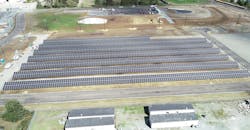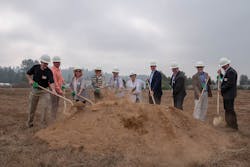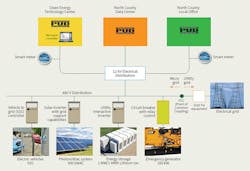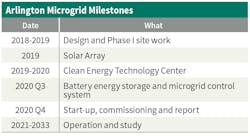Lessons from the Microgrid
On one of the remote Canadian Gulf Islands sits an isolated but idyllic vacation home cut off from one of the modern conveniences people take for granted: the electric grid. The small A-frame house is surrounded by trees and brush. Stairs go down to the beach and end on a rocky shore. Visitors must arrive by boat. There are no roads. No crowds. No grid. The owners of the home on Twilight Island have created a microgrid to power their residence. The island’s microgrid uses solar and wind power for generation, a direct-current (DC) panel with an inverter to convert to alternating current (AC) and lead-acid batteries for storage. It is a do-it-yourself solution. The result is a home that can be powered off the grid, no matter the weather.
The concept behind the microgrid is becoming more common in the changing world of energy. Microgrids, or groups of interconnected loads and energy sources that can operate independent of the grid, are being built across the United States. Unlike the tiny microgrid running Twilight Island, many microgrids are used to power critical infrastructure like hospitals, schools and airports in times of disaster. When Hurricane Sandy hit New Jersey in 2012, Princeton University’s microgrid, powered by a gas turbine and solar array, kept the lights on for critical research projects and computer services while much of the state was dark. Puerto Rico is using microgrids to rebuild electrical infrastructure damaged during Hurricane Maria in 2017. In early January 2019, the Puerto Rico Energy Commission unveiled a proposal for future microgrid installations on the island.
Microgrids are built for various reasons. Along with using microgrids for resiliency during emergency operations, utilities are designing and building them to help delay or cancel costly T&D investments (for example, the replacement of new substations and undersea cables as well as the removal of poles and wires that cut through sensitive wilderness areas or crowded urban environments). In the U.S. Pacific Northwest, Snohomish County Public Utility District (PUD) is in the process of building the Arlington Microgrid and Clean Energy Technology Center, with partial funding from the Washington State Department of Commerce Clean Energy Fund 2. The PUD will pair a 500-kW solar array with a 1-MW, 1-MWh lithium-ion (Li-ion) battery energy storage system, so a soon-to-be-built backup data center and office can run independent of the grid.
Arlington Microgrid
The Arlington Microgrid project will also include vehicle-to-grid (V2G) technology. The PUD anticipates the growth of electric vehicles, especially fleet vehicles, and sees the importance of learning about their impact on the electric grid. The V2G technology will enable the PUD to test how the electric car batteries can provide another source of electric storage to benefit the microgrid as well as the overall grid.
The PUD’s project will focus on multiple fronts, including renewable energy integration, solar smoothing, grid support and ancillary services, as well as community outreach and education. However, grid resiliency during disaster recovery is the main rationale for the project. The system will be sized to power critical facilities at the new Arlington, Washington, office and backup data center during a major and extended outage caused by a windstorm or worse, an earthquake. In the worst-case earthquake scenario, the region’s electric grid, along with transportation infrastructure, could be damaged for months.
The microgrid will have a fossil-fueled (diesel) emergency generator, but the longer the microgrid can run on solar and battery power, the longer it can preserve the fuel stored on-site. In an emergency, the data center and crucial support systems located at the office will remain online. This will enable PUD line workers and engineers who are critical to restoring power to begin work immediately and continue without interruption.
The Arlington Microgrid can be thought of as a solar-powered emergency generator with a day job. Usually, an emergency generator sits and waits for a power outage. When something happens to the main electrical grid, it springs to life and provides electricity for an important asset. But a microgrid works every day to bring clean solar power to customers. If there is an outage, the system can disconnect from the main grid and continue to power its critical systems. As long as the sun is shining, the microgrid has the fuel it needs.
Solar For All
The 500-kW solar array was constructed early to support a community solar pilot program and to take advantage of the Washington Production Incentive, as the Clean Energy Fund could not be used for the solar part of the microgrid. One of the most experienced solar installers in the Pacific Northwest, A&R Solar, finished construction of the 500-kW solar array in May 2019. It is made up of 1,620 380-W solar panels manufactured by Renewable Energy Corp.
The system’s inverters, which convert the DC produced by the PV systems into AC, were manufactured by SMA Solar Technology AG. They are advanced smart inverters with grid-support capabilities. They meet the requirements of IEEE 1547, UL 1741 Supplement A (SA), California Rule 21 and Hawaiian Electric Co. (HECO) Rule 14H.
The solar array is not only the future power supply for the microgrid, it is also the PUD’s first community solar project and the largest community solar project in Washington state. Community solar projects make it easier for utility customers to invest in solar energy. They require minimal upfront costs without installation hassles and maintenance concerns. For example, if a PUD customer has a roof that does not receive adequate sunlight or the customer does not own the home, they can still support carbon-free renewable energy and enjoy its benefits through the purchase of solar shares. In return for their investment, community solar customers receive bill credits and incentives from the state.
The response to the community solar program has been strong. Half the solar units were reserved the first day of launch, and the rest within one month. There are more than 500 customers participating, not to mention a waiting list. Community solar participants will be able to visit both the solar array and Clean Energy Technology Center, which will showcase this new energy technology to the public, business sector, researchers, universities, government agencies and more.
Energy Storage
The Arlington Microgrid will store energy in two ways:
- 1-MW Li-ion battery energy storage system
- V2G system using two Mitsubishi charging stations and two Nissan LEAF vehicles to store energy generated by the solar array.
Both energy storage systems will expand the PUD’s work on Modular Energy Storage Architecture (MESA).
MESA is an open standard for energy storage that focuses on the physical, electrical and communication interconnection of components in an energy storage system. The PUD anticipates MESA will reduce the complexity of energy storage systems, enable compatibility between a variety of system components and significantly reduce nonrecurring engineering costs.
The PUD currently has two MESA-compliant battery storage systems: A Li-ion battery energy storage system (2 MW, 1 MWh) and a vanadium redox flow system (2.2 MW, 8 MWh). These are stand-alone systems sited at substations. Currently, they are used for grid support functions, such as peak shaving and energy arbitrage. Both projects were partially funded by the Washington State Department of Commerce Clean Energy Fund 1. These projects help the PUD and Department of Commerce understand the technical and economic challenges associated with energy storage.
Additionally, with the growing interest in electric fleet vehicles, the microgrid will serve as a test lab for for game-changing V2G technology. A V2G charging station can charge a car or enable the energy stored in the vehicle to flow back to the grid for reuse during an outage. For example, a Nissan LEAF can supply 40 kWh to 60 kWh to the grid from its Li-ion battery during an outage at night. The battery is recharged by the solar array during the day with minimal impact on the battery’s life. The PUD’s microgrid project will study the feasibility of using V2G technology and electric fleet vehicles for grid support.
The battery energy storage systems will be connected to the microgrid through the Doosan Grid-Tech Distributed Energy Resource Optimizer (DERO), enabling the battery to be called on for grid support and ancillary services, like solar smoothing and peak shaving, when it is not being used as an emergency generator. The PUD has used DERO at its other two battery energy storage projects to mitigate energy imbalance, real-time changes in load forecasts and wind generation forecasts, and energy arbitrage.
Battery costs have been dropping over the past six years. Costs associated with battery energy storage have come down 70% and, as of 2019, sit at US$200/kWh to $250/kWh for the battery itself, not including the power conversion system or battery management system.
Learning Lessons
The PUD’s Arlington Microgrid project is one of the first utility-scale microgrids in the Northwest. Other Pacific Northwest utilities—including Avista Corp., Puget Sound Energy, Seattle City Light, Orcas Power & Light Coop and Energy Northwest — are building their own microgrids for a variety of purposes. They also received partial funding from the Washington State Department of Commerce Clean Energy Fund 2. These projects will enable regional utilities to better understand the many benefits of combining their current electrical generation systems with renewable energies and microgrids. The PUD has partnered with the University of Washington to study and analyze the economics and technical challenges of building microgrids, energy storage and solar energy systems in the Pacific Northwest.
With construction set for completion in 2020 and commissioning later the same year, the Arlington Microgrid will begin testing in 2021. What the PUD learns from those studies will inform industry leaders: Are microgrids worth the investment? In addition to its investment, the PUD has received $3.5 million in funding from the Washington Clean Energy Fund and an additional $900,000 from community solar sales, for a total investment of $12 million in the Arlington Microgrid project.
For now, these technologies are relatively expensive. But as equipment and engineering costs fall, it makes sense for critical facilities like airports, hospitals, fire departments and government agencies to rely on solar, wind and battery energy storage instead of fossil fuels.
For instance, across the street from the PUD’s microgrid project is the small Arlington Municipal Airport. This facility could serve as a crucial transportation hub in the aftermath of a devastating earthquake. Could or should the airport one day build its own microgrid to remain operational during a disaster without fossil-fuel backup? It is imperative the region’s electric utilities and other similar agencies begin to answer and address these important issues.
Sidebar: Contributing Partners and Contracts
- The battery, microgrid control system and auxiliary equipment are partially funded by the Washington Department of Commerce Clean Energy Fund.
- The solar array is partially funded by the Washington State Production Incentive and the Community Solar Program.
- The following organizations and companies have been hired through a competitive process to assist with the project:
- The University of Washington is assisting with studies detailing the technical issues and economics of the project.
- Burns & McDonnell is providing engineering services for the design, start up and commissioning of the project.
- Mitsubishi Electric Power Products Inc. is providing the V2G chargers and engineering support for integration with the microgrid control system.
- A&R Solar supplied and constructed the solar array.
- The battery and microgrid control vendor is to be determined.
- The equipment installation contractor is to be determined.
For more information:
Avista | www.myavista.com
A&R Solar | www.a-rsolar.com
Burns & McDonnell | www.burnsmcd.com
Doosan GridTech | www.doosangridtech.com
Energy Northwest | www.energy-northwest.com
MESA Alliance | www.mesastandards.com
Mitsubishi Electric Power Products | www.meppi.com
Orcas Power & Light Coop | www.opalco.com
Puget Sound Energy | www.pse.com
REC | www.recgroup.com
Seattle City Light | www.seattle.gov/light
SMA | www.sma-america.com
Snohomish County PUD | www.snopud.com
About the Author
Scott Gibson
Scott Gibson is a principal engineer with Snohomish County PUD and a 1987 graduate from the University of Wyoming where he received a BSEE. After graduation, Gibson worked for Boeing and then with a consulting company designing building electrical systems. In 2000, he joined the PUD and is now working on new electrical generation projects. Gibson worked on the development of a tidal generation project and helped to design and construct two "run of the river" hydroelectric projects. He is now the project manager for the PUD’s latest energy storage project — The Arlington Microgrid.
Aaron Swaney
Aaron Swaney is a public relations and media liaison with Snohomish County PUD. Swaney is a 2001 graduate of the University of Washington with a BA in Political Science. Before joining Snohomish PUD, he was a reporter and editor for The Daily Herald in Everett, Washington, for more than a decade.






